When it comes to legendary, world-changing ad campaigns, few can touch DeBeer’s A Diamond Is Forever.
It scaled the Mount Everest of Advertising challenges: it grew the market for the product, rather than simply stealing market share from a competitor.
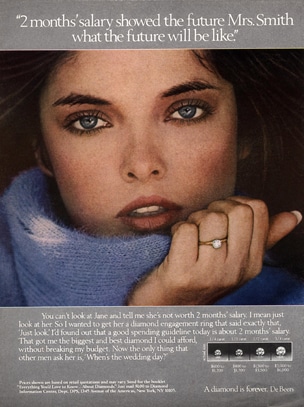 In other words, it dramatically changed consumer behavior.
In other words, it dramatically changed consumer behavior.
Hey, there’s a reason Advertising Age named “A Diamond Is Forever” the best advertising campaign of the 20th century!
And here’s the kicker: the most effective elements of the campaign were born of necessity.
They were, in fact, forced upon De Beers, and in turn, upon their advertising firm, N.W. Ayer & Son.
But to understand all that, you need to know a bit o’ history first.
Why You Won’t See De Beers’ Logo, or Even Their Name, In The Ads
De Beers, you understand, was a monopoly.
A monopoly specifically manipulating the availability of diamonds to artificially increase their pricing and profits.
I don’t write that as an accusation, just as a historical fact that put the company at odds with the United States Anti-Trust laws.
The US Government even tried to bring suit against De Beers but was thwarted only because De Beers wasn’t a US Company.
And so to keep out of the clutches of US Gov oversight, De Beers never had offices in the United States, and would naturally be prevented from advertising itself in the US.
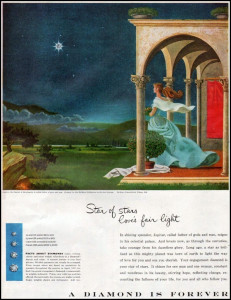 In other words, forget about typical client demands to “Make the Logo Bigger.”
In other words, forget about typical client demands to “Make the Logo Bigger.”
They couldn’t show a logo or brand at all in the ads!
Moreover, since De Beers sold cut diamonds, they couldn’t really advertise specific jewelry in their ads.
And because they were a monopoly with over 90% market share, they couldn’t expand their revenues by stealing market share from competitors, the way most businesses do.
These are some pretty hefty obstacles for any advertising firm.
Now let’s add onto that the fact that the product was essentially bereft of features and benefits.
It’s a freaking rock.
Yes, it’s pretty and it glitters. Just like most other gem stones.
Except most other precious gemstones are colored, and so are arguably even prettier, which is why fancy colored diamonds fetch a premium.
So now that we’ve got a good handle on the historical context for the obstacles, let’s look at the objectives.
What De Beers Hoped to Make Happen Way Back in 1938
In 1938 a representative of Sir Ernest Oppenheimer, then president of De Beers Consolidated Mines, wrote to Ayer to inquire about “the use of propaganda in various forms” to boost the sales of diamonds in America.
Since World War 1, only about half the amount of diamonds were sold as before the war, with the Great Depression reducing sales even further.
Betrothal rings were a thing, of course. But diamond engagement rings were a rarity, and most people considered them a waste in comparison to other luxury items.
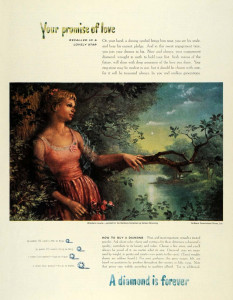 Only the top 10% of the population gave or received diamond engagement rings. And even then, they amount spent on the diamond was paltry compared to todays standards.
Only the top 10% of the population gave or received diamond engagement rings. And even then, they amount spent on the diamond was paltry compared to todays standards.
There was no de rigueur social expectation of a diamond engagement ring, and certainly no set standard for expected size or expense.
So the goal was to propagandize the American public into buying diamond engagement rings with higher quality stones.
To quote from the brief given to Frances Gerety, the copywriter who penned the immortal tagline “A Diamond Is Forever”:
“We are dealing primarily with a problem in mass psychology. We seek to maintain and strengthen the tradition of the diamond engagement ring — to make it a psychological necessity.
Target audience: some seventy million people fifteen years and over whose opinion we hope to influence in support of our objectives.”*
And in the absence of ads trying to make a direct sale, or directly promoting the brand, or any given benefit of the product, the campaign was forced to “push” the only thing it could: the emotional currency attached to the diamond.
So De Beer’s invested $500,000 per year (or about $9.2 million in 2020 dollars) for three years to see if N.W. Ayer & Son could work some magic.
And boy did they!
By 1941 diamond sales had increased by 55 percent.
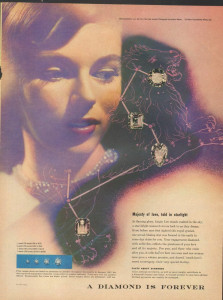 Then they exploded after World War II, to coincide with the Baby Boom.
Then they exploded after World War II, to coincide with the Baby Boom.
But of course, that happened before Frances Gerety transformed and encapsulated the campaign with her famous tagline. That didn’t happen till 1947.
But all this is talk of advertising, whereas Sir Ernest Oppenheimer spoke of propaganda.
The difference is that Frances Gerety and her ads were paired with the work of Dorothy Dignum at N.W. Ayer & Son’s public relations division.
Dorothy had high schools teach graduating seniors about diamonds, specifically the famous “Four Cs.”
She worked to have Hollywood and Fashion magazines do feature pieces on diamonds as worn by movie stars and celebrities. She went heavy on product placement and it payed off big time.
She even worked to get the “Diamonds are a girls best friend” dance sequence placed into Gentlemen Prefer Blondes.
The combined effect of the PR and advertising campaigns was to present the idea that diamonds were a gift of love: the larger and finer the diamond, the greater the expression of love.
The results?
Between 1939 and 1979, De Beers’s wholesale diamond sales in the United States increased ten-fold, from $23 million to $2.1 billion
The Lessons — How De Beers Benefited from Their Restrictions:
-
Their ads didn’t look, read, or feel like ads.
Because their name and logo had to be absent from the ads, the A Diamond Is Forever campaign was an ideal example of “native advertising” (aka an “advertorial”) before there was even a name for it. An effect their copy and art choices amplified.
Clients often want their ads to sound “professional,” which is to say, like an ad. Or they want to follow an advertising trend everyone else is doing. Don’t make that mistake. Take a lesson from De Beers and make your ads sound distinctly different than the other ads on the radio or TV. The less they sound like an ad, the better.
-
Their ads used glamour to “romance the stone” without focusing on the stone itself.
The ads spoke to the longings and desires of the customer. The customer was the hero of the ad, not the product. The diamond merely aided the hero of the ad, acting as a portal to achieving their deepest aspirations.
Not every product or service can make use of Glamour techniques, but more can than you might expect. And when products and services can’t be romanticized, the people behind them can and should be.
-
Their ads attached meaning and emotions to the SYMBOL of the diamond engagement.
When the campaign was first launched, diamonds were seen as a wasteful extravagance. Young couples would rather have a car or a washing machine than a diamond. So the ads couldn’t be about the stone itself. Instead they focused on what the stone meant to the man giving the ring, and what the diamond ring would mean to the woman receiving it.
Diamonds were presented as a solution to problems the buyer was already trying to solve. How do I tell the woman I love that my love is not only real, but permanent? How do I give her something that will be with her forever? How do I signal to her, and allow her to signal to others, that I’m successful and “making it”?
Now, you might be thinking that this only applies to romantic products, but just look at how Michelin did the same thing with “Because so much is riding on your tires…”
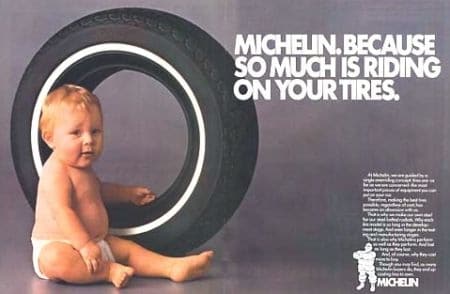
-
They went HEAVY on product placement and social proof.
There are two primary ways people make decisions: 1) cost-benefit, and 2) what kind of person am I (or do I aspire to be) and what would that kind of person do in this situation. By showcasing how celebrities and socialites and movie stars adored diamonds and considered them an essential and expected part of romance, De Beers doubled down on the second decision making style, mostly because there was no cost-benefit argument to be made.
Now, you might not have the PR power or budget to put that kind of social proof to work, but you can harness the power of social proof with testimonial ads and customer reviews and other user-generated content. You can also use dialogue style ads to present fictionalized social proof. You can also figure out how to use branded items as a substitute product placement. Make the use of your product and service more conspicuous, if possible. If a used car dealership can figure out how to do this, so can you:
-
They understood that they had to reach people before they were in the market
You can’t make anyone buy an engagement ring if they’re not planning a proposal in the near future. Nor can you predict when they’ll meet and fall in love with someone to whom they’ll want to propose. You have to influence the persons ideas around engagement ring expectations before they ever reach that point, and reap the rewards of payday whenever that happy moment finally arrives.
Breaking out of the direct response mindset and into the branding mindset is a big leap for many business owners, but it’s one that can come with huge rewards for anyone selling a mass market product or service.
-
Their ads gave the customer a mental framework that reduced uncertainty
I’ve previously written about the alchemy of the sleeper effect, in which advertising claims are transmuted from what the company says into what “they” say. And “A Diamond Is Forever” is a perfect example of this in how it turned “two month’s salary” as a benchmark made up by De Beers into a benchmark widely accepted as “traditional wisdom.”
It’s the same with the idea of one full carat weight as a benchmark. Without these two frameworks, how would anyone know what to spend or how big of a diamond to get? How would you know what your with-any-luck-fiancée would expect? By providing these anchor points, De Beers dramatically increased the amount the average man spent on his engagement ring, and these frameworks were happily accepted as risk and uncertainty reducing tools by these same men.
And, yes, you too can help your prospects mentally frame their decisions in ways that reduce their uncertainty. If none come to mind, let me suggest you start by offering loop-hole-free guarantees and quality / convenience assurances.
So take these lessons to make your own advertising better.
While you’re at it, you might want to contemplate what obstacles are confronting your advertising and marketing efforts and how could you turn them into advantages rather obstacles.
And if you’d like help with either task, feel free to reach out.
*Quote taken from the well-researched and documented Novel, The Engagements, by J. Courtney Sullivan
- Getting a Foot in the Door — Of Perception - November 27, 2025
- What Digital Superstars Know About Offline Advertising - November 17, 2025
- Unmistakable: A Tale of Two Boots and Branding Done Right - November 8, 2025
